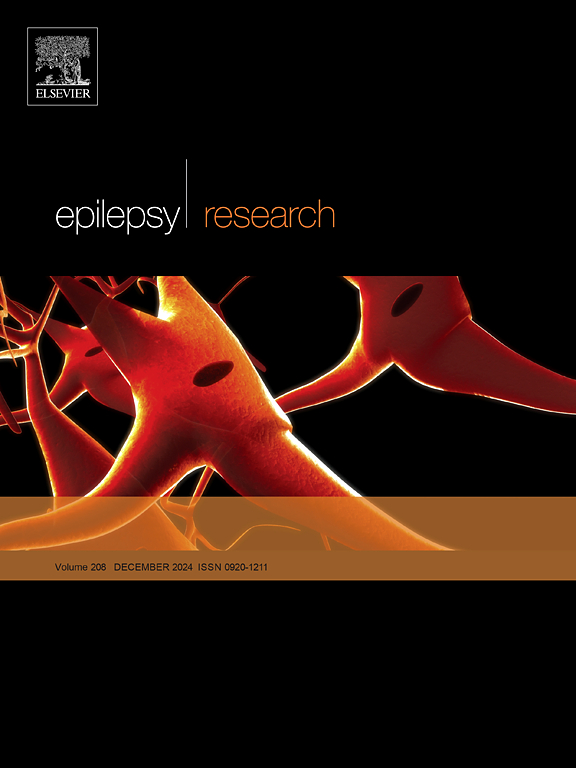Seizures associated with dural arteriovenous fistulas: A systematic review of cases
IF 2
4区 医学
Q3 CLINICAL NEUROLOGY
引用次数: 0
Abstract
Objective
Dural arteriovenous fistulas (DAVFs) are an unusual cause of seizures. In this systematic review, we aim to describe the clinical features, paraclinical findings, management, and prognosis of cases of DAVF-related seizures, raising awareness for a potentially treatable cause of epilepsy.
Methods
This review was registered on PROSPERO (CRD42024529316). We searched OVID MEDLINE, OVID Embase, Web of Science, and Google Scholar for case reports/series of patients presenting with seizures associated with DAVFs. Original studies describing at least two out of four outcome categories (clinical features, paraclinical findings, treatment, and prognosis) were included. The methodological quality of each study was evaluated using a standardized tool. We performed descriptive analyses to summarize the clinical characteristics of all cases. We repeated these analyses while excluding cases where seizures may have had a likelier cause than DAVFs.
Results
In total, 120 patients were included from 94 articles. Median age was 57 years, and most patients were male (70 %). The most common manifestations accompanying seizures were headaches (22 %). Status epilepticus occurred in 38 % of cases. DAVFs were most commonly in the left hemisphere. The main venous sinus involved was the transverse sinus. Cortical venous reflux was present in almost all cases (93 %); most DAVFs were considered aggressive according to Cognard and Borden classifications. Seizure freedom was most common following angiographic interventions.
Conclusion
DAVFs, even when uncomplicated, can be a potential cause of treatable seizures. More aggressive DAVFs with cortical venous reflux seem to be the main culprit. Angiographic interventions can help achieve seizure freedom.
癫痫发作与硬脑膜动静脉瘘:系统回顾的情况
目的硬脑膜动静脉瘘(DAVFs)是一种罕见的癫痫发作原因。在这篇系统综述中,我们的目的是描述davf相关癫痫发作的临床特征、临床旁表现、处理和预后,提高人们对潜在可治疗癫痫原因的认识。方法本综述在PROSPERO注册(CRD42024529316)。我们检索了OVID MEDLINE, OVID Embase, Web of Science和b谷歌Scholar,以获得与davf相关的癫痫发作的病例报告/患者系列。原始研究描述了四种结果类别(临床特征、临床旁表现、治疗和预后)中的至少两种。使用标准化工具评估每项研究的方法学质量。我们进行描述性分析以总结所有病例的临床特征。我们重复了这些分析,同时排除了癫痫发作可能有比davf更可能的原因的病例。结果94篇文献共纳入120例患者。中位年龄57岁,男性居多(70 %)。癫痫发作最常见的表现是头痛(22% %)。38 - %的病例发生癫痫持续状态。davf最常见于左半球。受累的主要静脉窦为横窦。几乎所有病例均出现皮质静脉回流(93 %);根据Cognard和Borden的分类,大多数davf被认为是侵略性的。血管造影干预后癫痫发作自由最为常见。结论即使不复杂,davf也可能是可治疗的癫痫发作的潜在原因。伴有皮质静脉回流的更具侵袭性的davf似乎是罪魁祸首。血管造影干预可以帮助实现癫痫的自由发作。
本文章由计算机程序翻译,如有差异,请以英文原文为准。
求助全文
约1分钟内获得全文
求助全文
来源期刊

Epilepsy Research
医学-临床神经学
CiteScore
0.10
自引率
4.50%
发文量
143
审稿时长
62 days
期刊介绍:
Epilepsy Research provides for publication of high quality articles in both basic and clinical epilepsy research, with a special emphasis on translational research that ultimately relates to epilepsy as a human condition. The journal is intended to provide a forum for reporting the best and most rigorous epilepsy research from all disciplines ranging from biophysics and molecular biology to epidemiological and psychosocial research. As such the journal will publish original papers relevant to epilepsy from any scientific discipline and also studies of a multidisciplinary nature. Clinical and experimental research papers adopting fresh conceptual approaches to the study of epilepsy and its treatment are encouraged. The overriding criteria for publication are novelty, significant clinical or experimental relevance, and interest to a multidisciplinary audience in the broad arena of epilepsy. Review articles focused on any topic of epilepsy research will also be considered, but only if they present an exceptionally clear synthesis of current knowledge and future directions of a research area, based on a critical assessment of the available data or on hypotheses that are likely to stimulate more critical thinking and further advances in an area of epilepsy research.
 求助内容:
求助内容: 应助结果提醒方式:
应助结果提醒方式:


